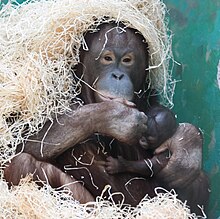Pongo pygmaeus
| Bornean orangutan | |
|---|---|
 |
|
| Male at the Moscow Zoo | |
 |
|
| Female with infant at the Bojnice Zoo | |
| Scientific classification | |
| Kingdom: | Animalia |
| Phylum: | Chordata |
| Class: | Mammalia |
| Order: | Primates |
| Suborder: | Haplorhini |
| Family: | Hominidae |
| Genus: | Pongo |
| Species: | P. pygmaeus |
| Binomial name | |
|
Pongo pygmaeus (Linnaeus, 1760) |
|
 |
|
| Distribution in Borneo | |
| Synonyms | |
|
P. agris (Schreber, 1799) |
|
| NCBI genome ID | 10714 |
|---|
P. agris (Schreber, 1799)
P. batangtuensis (Selenka, 1896)
P. borneensis Röhrer-Ertl, 1983
P. borneo (Lacépède, 1799)
P. brookei (Blyth, 1853)
P. curtus (Blyth, 1855)
P. dadappensis (Selenka, 1896)
P. genepaiensis (Selenka, 1896)
P. landakkensis (Selenka, 1896)
P. morio (Owen, 1837)
P. owenii (Blyth, 1853)
P. rantaiensis (Selenka, 1896)
P. rufus (Lesson, 1840)
P. satyrus (Linnaeus, 1766) [in part]
P. skalauensis (Selenka, 1896)
P. sumatranus (Mayer, 1856)
P. tuakensis (Selenka, 1896)
P. wallichii (Gray, 1871)
P. wurmbii (Tiedemann, 1808)
The Bornean orangutan (Pongo pygmaeus) is a species of orangutan native to the island of Borneo. Together with the Sumatran orangutan, it belongs to the only genus of great apes native to Asia. Like the other great apes, orangutans are highly intelligent, displaying advanced tool use and distinct cultural patterns in the wild. Orangutans share approximately 97% of their DNA with humans.
The Bornean orangutan is a critically endangered species, with deforestation, palm oil plantations and hunting posing a serious threat to its continued existence.
The Bornean orangutan and the Sumatran orangutan diverged about 400,000 years ago, with a continued low level of gene flow between them since then. The two orangutan species were considered merely subspecies until 1996; they were elevated to species following sequencing of their .
The Bornean orangutan has three subspecies:
There is some uncertainty about this, however. The population currently listed as P. p. wurmbii may be closer to the Sumatran orangutan (P. abelii) than to the Bornean orangutan. If this is confirmed, P. abelii would be a subspecies of P. wurmbii (Tiedeman, 1808). In addition, the type locality of P. pygmaeus has not been established beyond doubt; it may be from the population currently listed as P. wurmbii (in which case P. wurmbii would be a junior synonym of P. pygmaeus, while one of the names currently considered a junior synonym of P. pygmaeus would take precedence for the taxon in Sarawak and northern West Kalimantan). Bradon-Jones et al. considered P. morio to be a synonym of P. pygmaeus, and the population found in East Kalimantan and Sabah to be a potentially unnamed separate taxon.
...
Wikipedia

